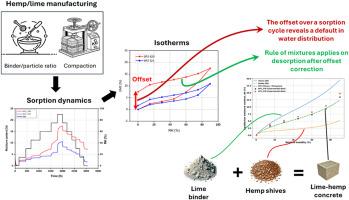石灰-大麻混凝土与水蒸气相互作用的深入分析:水违约的影响和吸附行为的预测
IF 10.8
1区 工程技术
Q1 CONSTRUCTION & BUILDING TECHNOLOGY
引用次数: 0
摘要
石灰-大麻混凝土(LHC)因其低能耗、碳储存能力和冬季和夏季舒适的有趣特性而成为一种可持续建筑材料。然而,全面了解其水分行为对其在建筑中的发展和应用至关重要。本研究研究了密度(321-478 kg/m³)和粘合剂/颗粒重量比(BP = 1和2)不同的四种配方的LHC吸湿行为和等温线特性。使用严格的平衡标准,超过3000小时的动态蒸汽吸附(DVS),实验显示一些配方在RH水平高于60%时未能达到吸附平衡。表明不可逆过程,其特征是在0% RH下平衡水分含量(EMC)在完整循环后出现偏移。这些现象是由于混合时可用水量不足和/或过度压实造成的。高质量比(B/P=2)和显著压实的配方,如BP2_420,具有最高的解吸偏移量(7.5% EMC),而低质量比(B/P=1)的配方,如BP1_379,由于水分分布较好,解吸偏移量减小到2%以下。研究还表明,可逆吸附行为,校正偏移量,可以准确地描述使用Guggenheim-Anderson-de Boer (GAB)模型。最后,结合麻屑颗粒和粘结剂的GAB参数,混合规则可靠地预测了吸附等温线,偏差限制在2.3%以内。本文章由计算机程序翻译,如有差异,请以英文原文为准。


In-depth analysis of Lime-hemp concrete and water vapor interactions: Effect of water default and prediction of the sorption behavior
Lime-hemp concrete (LHC) emerges as a sustainable building material due to its low embodied energy, carbon storage capabilities, and interesting properties for both winter and summer comfort. However, a comprehensive understanding of its moisture behavior is pivotal for its development and application in construction. This study investigates the moisture sorption behavior and isotherm characteristics of LHC across four formulations varying in density (321–478 kg/m³) and binder/particle weight ratios (BP = 1 and 2). Using a strict equilibrium criterion, over 3000 h of Dynamic Vapor Sorption (DVS), experiments revealed some formulations failed to reach equilibrium during adsorption at RH levels above 60 %, indicating irreversible processes characterized by offsets in equilibrium moisture content (EMC) at 0 % RH after a complete cycle. These phenomena were attributed to insufficient water availability during mixing and/or excessive compaction. Formulations with a higher weight ratio (B/P = 2) and significant compaction, such as BP2_420, exhibited the highest desorption offset (7.5 % EMC), while those with a lower B/P weight ratio (B/P = 1), such as BP1_379, showed reduced offsets below 2 %, due to better water distribution. The study also showed that reversible sorption behavior, corrected for offsets, could be accurately described using the Guggenheim-Anderson-de Boer (GAB) model. Finally, the rule of mixtures reliably predicted sorption isotherms by combining the GAB parameters of hemp shive particles and binder, with deviations limited to a maximum error of 2.3 %.
求助全文
通过发布文献求助,成功后即可免费获取论文全文。
去求助
来源期刊

Cement & concrete composites
工程技术-材料科学:复合
CiteScore
18.70
自引率
11.40%
发文量
459
审稿时长
65 days
期刊介绍:
Cement & concrete composites focuses on advancements in cement-concrete composite technology and the production, use, and performance of cement-based construction materials. It covers a wide range of materials, including fiber-reinforced composites, polymer composites, ferrocement, and those incorporating special aggregates or waste materials. Major themes include microstructure, material properties, testing, durability, mechanics, modeling, design, fabrication, and practical applications. The journal welcomes papers on structural behavior, field studies, repair and maintenance, serviceability, and sustainability. It aims to enhance understanding, provide a platform for unconventional materials, promote low-cost energy-saving materials, and bridge the gap between materials science, engineering, and construction. Special issues on emerging topics are also published to encourage collaboration between materials scientists, engineers, designers, and fabricators.
 求助内容:
求助内容: 应助结果提醒方式:
应助结果提醒方式:


